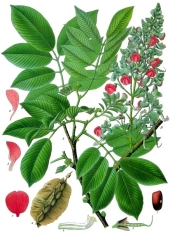posted 6 years ago
Hello!
I am new Permies, and am about 4 years into the permaculture rabbit hole. About a year and a half ago, I bought my own little home in Las Vegas, NV where I work as a nurse. It is slowly transforming from a concrete and rock heat island to a very cozy permaculture garden. Seeing as how I am a nerd, I'm starting to think very nerdy thoughts about plants and health. Well, actually I started heading down the natural health trail after being sick with Lyme Disease for 10 years getting misdiagnosed. I guess I've been experimenting on myself for a long time with natural remedies, and I love the 'why' and 'how' of biology. So... not only do I plan on happily continuing down the permaculture rabbit hole, but I want to do some real, measurable and reproducible research.
I was hoping someone out there had done something similar, or had contacts or knowledge of health research related to permaculture. Let me give one example of a research idea I had so that you can kind of get an idea of what I'm talking about:
Different plants contain different biochemical constituents which benefit humans, for example, the hydrocarbon limonine found in the essential oils of Lemon, Bergomot, etc. has been proven to shrink tumors in mice in a.... I want to say Japanese study. Also, both humans and plants have electrical fields. This is measurable. A study was done that showed the electrical fields of someone very ill with something like stage 4 cancer was significantly different than that of a healthy person.
My question is this... we always think that we are tending to the plants. What if the plants are stimulated by unique changes in a human's electrical field to produce more or less of their particular biochemical properties? What if someone with arthritis grows a Rosemary, lets say, and the anti-inflammatory chemicals that plant produces is increased compared to what it would have been if a healthy person had grown that plant? What if there is more symbiosis occurring than we ever thought?
I want to test this. My plan so far is to find a plant that has a natural pain reliever (I'm not growing weed.... don't even go there.... I like keeping my nursing license) and is also able to be cloned. I would establish 2 clones of the mother plant in the same soil, with the same growing conditions, one as the control, one as the test. The only difference in their care would be that prior to caring for one of the plants, I would use an electrical stimulation (like that chiropractic gismo) to cause myself to be in so much pain that I have a noticeable adrenaline dump (I'd measure this by taking my vital signs first). So every time one of the plants was being taken care of, I would be in considerable pain. Then, once the plants got to maturity, I could have samples tested for levels of the pain reliving biochemical. My theory is that the plant who I was in pain around, would be triggered to produce more pain reliever due to the change in my own body chemistry and electrical field.
That is my basic idea. I have A LOT of details to get ready, like what plant is A) produces a measurable pain relieving biochemical and B) can be cloned so that both my test and control plants can have the same genetics. I'd also need to research the extent of human's electrical fields so that my control plant can be placed far enough away and wouldn't be affected by my electrical field while I was in pain.
This is just one of MANY experiments I want to run. But I just wanted to throw this out there and see if anyone knows of a good lab to send things too, any plant/permaculture studies that might help or interest me, etc. Any medical permie nerds out there?
Thank you!
Kelly B. RN OCN
"Tell me not in mournful numbers, life if but an empty dream." Longfellow

 3
3




 1
1




 1
1




 2
2






















